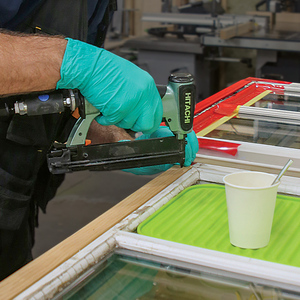I made the poor decision to install a 3-piece fiberglass bathtub surround for a client. It’s the kind that is a thin material that is adhered directly to the wall surface with construction adhesive. At the time of installation I was concerned about the flexibility of the material where it meets the tub edge. Constructed correctly, the underlying wall surface only comes down to the lip of the tub. Thus a gap the depth of the wall material and the height of the tub lip exists behind the surround material just above the tub platform. Thus there’s no solid backing for the surround at that point. That apparently allows for more movement than the caulk at the base of the surround can withstand. The acrylic bath caulk joint along the base of the surround is already opening up just months after installation.
The tech dept. of the manufacturer was of no help. Rarely do I find anyone staffing these departments that has actually had any hands-on experience with the products they’re supposed to be experts on.
Does anyone have any suggestions on how I might get a long-lasting seal at the base of the surround where it meets the tub?
Thanks for any expertise anyone might provide.
Laura



















Replies
Can you get a backer rod stuffed in to help hold the caulk?
I won't lament on the liner itself as you have already regretted installing it in the first place. OOps I am lamenting aren't I?
Only other way would be some canned foam. But I worry that it might expand too much and push the surround out and case more trouble than it fixes.
Tho I've never done it, some here have suggested caulking under game conditions. Occupied with maybe tub full of water. Also, seasonal change in a caulk joint in a house is normal as things dry out in the winter. I've had the best luck with joints caulked in the winter. Those done in the summer seem to fail more often.
Some other answers perhaps for more information. What's the tub made of, caulk brand or type, and did you trowel the mastic or run a pattern of gun glue? best of luck on the next attempt.
__________________________________________
Remodeling Contractor just outside the Glass City.
http://www.quittintime.com/
You can buy at HD what they call a solid caulk (its not really caulking) that comes in a roll with sticky stuff on the back that adheres over the top of the tub and to the wall. Just cut it to the sizes you need, peel the back off and stick it on.
BE well
Namaste
Andy
It's not who's right, it's who's left ~ http://CLIFFORDRENOVATIONS.COM
A couple of years ago, I started using an exterior grade door & window silicone caulk, rather than bathroom silicone caulk as it seems to provide better adhesion. At the time, I compared the ingredients on both kinds and noticed that the chemical makeup is slightly different. I have not had any problems since making this change.
Good luck.
I got an earfull from an old timer in our local Menards (HD equivalent) who was big into the DAP "frosting" tube caulk. He said it doesn't support mildew.
In my own home experiment I bought the 50 year GE white silicone and fitted the tub with it. On the corners of the tile wall I used the DAP. (Hey, I ran out of grout & 50 year stuff and it was Sunday night... Give a guy a break)
After 12 years of 4 showers a day in that little room I have to say the tub & tile Dap stuff is bright white and unmarked. The GE has marbled with mildew stains and it yellows when hit with cleanser or chlorine bleach. It does have a death grip on the tub & tile however. No leakage but it looks like merde.
Thanks for the suggestions so far for bathroom caulk.
Jet: There's no way to access the gap at this point because the surround goes all the way to the bath platform. I usually use backer rod before caulking a tiled bath wall. In this case, there was no way to hold the rod in before the surround was installed, and as a flexible material itself, I'm not sure it would help.
Calvin: The tub is cast iron, the surround is acrylic applied with a pattern of adhesive applied by gun per the manufacturers instructions, and the caulk is Dap's bathroom acrylic caulk. The surface was cleaned with alcohol the first time, MEK the second (per DAP technical department's suggestion).
Andy: I tried that tape caulk on a fiberglass unit that I didn't install and got pure adhesion and it doesn't look very good.
Steve-O: Silicone is my next try for sure, pending any other suggestions. Have you found the exterior caulk to be more prone to mildew?
Thanks again for the help.
Laura
I'm a tile guy, and this is what I do:
1. Install solid backing between the studs at the interface between the tub and whatever is going above it.
2. Attach the tub flange to the studs with nails or screws. Some guys add a strip of CPE or PVC shower liner about 4" wide under the flange, e.g., between the flange and the blocking, 2" above the flange and 2" below the flange.
3. Shim out the studs above the tub with 1/4" lattice or a couple drwall shims.
4. Add the fiberglass surround and hold the surround up from the tub about 1/4". Caulk that 1/4" gap with a good 100% silicone caulk.
Boris
"Sir, I may be drunk, but you're crazy, and I'll be sober tomorrow" -- WC Fields, "Its a Gift" 1927
After jacking up a sagging beam, I was faced with destroyed tile surround in my shower. I elected to go with a 3 piece surround because the intent was to fully remodel the bath at a future date. Having torn apart several showers, my assumption is that a shower will always leak. Carefull craftsmanship is the determaning factor as to when it will start to leak. One thing that I always noticed was that water could get behind the surround (or tile or...) but it couldn't drain out. (this is something of consideration for you guys that like to cover exterior trim with aluminum) When I installed this surround, I very carefully scribed it to the tub. It took me a couple of tries to get the perfect fit, but now the gap is tight enough that you can't get a playing card in there. Because of my desire to let the surround drain and the tight fit, there is no need for caulking at the tub-surround joint.
BTW-the adhesive caulk should also be placed in a vertical orientation so that the moisture that builds up behind the surround can drain down. I used a 30 degree cross hatch pattern that doesn't intersect. I then apply the caulk to the back sides of the lap joints so that it doesn't appear on the face of the surround. The only visable caulk is a tiny bead covering the top of the surround where it ends. The side benifit of having the caulking concealed is that there is no (visible) caulking to mildew.
I'll 2nd (or is it 3rd?) the 100% silicone caulk instead of the acrylic.
You might have to recaulk more frequently, but he silicone comes off nicer/easier than the acrylic ever will. It might give you more flexibility in the caulk joint and could solve your current movement problem (depending on how severe). Certainly the cheapest thing to try first.
No solid backing at tub/surround interface is a no no.
Tub suround tight to tub? Also a no no.
So? We then use acrylic caulk? Also a no no.
Try silicone caulk, that may save you from ripping this mess out. I doubt it will work if you don't have a >1/8" space, actually I doubt it will work at this point. Your bad decision was to do something you didn't know how to do. Sorry, but the facts are the facts.
Edited 10/16/2002 12:52:03 PM ET by Qtrmeg
I will be removing the acrylic caulk and using silicone.
I take offense to the suggestion that I didn't know what I was doing. I read all the material that was provided by the manufacturer and in every book I could find that had information on it. I even called the manufacturer's tech dept. AHEAD of installation when I anticipated the problem. They said the gap wouldn't be a problem, but I didn't feel confident in their knowledge.
The lack of a solid backing is only at the point where the solid wall meets the lip of the tub. Putting the wall any lower makes it susceptible to wicking moisture. The manufacturer said to have the surround meet the tub. Leaving a gap (as is standard for caulked joints) would have resulted in MORE flex again because of the 1/2" high space without the backing.
Instead of just telling me that I did it wrong, I would appreciate information on how I could have supplied that solid backing in front of the lip of the tub and in back of the surround in the first place. The problem is inherent in the thinness of the surround material itself.
I usually put shim shingles to the top lip of the tub on the studs and run my rock or CBU beyond the lip about 1/4" from the base of the tub.
Be well
Namaste
AndyIt's not who's right, it's who's left ~ http://CLIFFORDRENOVATIONS.COM
Can you drill very small holes and inject the caulk behind the liner to fill the void? This may work if you tool the caulk smooth over the holes. Should be nearly invisible if done right. In the future I would find some filler that is waterproof to apply in the void. Maybe like corian or plastic, or fill it with durabond etc.
Sorry, Mark. I missed your suggestions. The corian/plastic idea is interesting; I guess strips could be siliconed, but alignment could be tricky because their is typically a slight cove at the point of the flange to assist drainage. The durabond seems like a viable solution though. Firmer than the foam I'm betting.
Thanks again to all who have offered their advice and sympathies.
I also will admit to installing cheap crap on occasion, and can add that thick gobs of silicone will hide a multitude of sins, mine included. There is a latex foam available, the name of which I'm forgetting now, that has a minimum expansion rate. Might work for future applications, and it cleans up easier than the other stickier stuff. You bettter move quick though, as it would harden before you got the sheet up on the wall. Good luck, and remember you are not alone out there.
Dan
Plumb
Kind of what Mark said but.....drill small holes at the very bottom where your going to caulk anyway and inject aresol foam insulation from a can. I think one brand is called GREAT STUFF...It expands a realllllll lot and gets hard and is water resistant. I bet four holes big enough to get the little tube in would really do the job. Just be careful not to squirt to much in each hole as it really expands a lotttttttt!!!!!!!!!!!!
Be well
Namaste
andyIt's not who's right, it's who's left ~ http://CLIFFORDRENOVATIONS.COM
My vote is silicone caulk too. I do think Dap is more mildew resistant but silicone fills and sticks and thats what you need. You need not feel bad that you made a mistake, even though you researched it. It is difficult to get decent answers from those tech lines unless its some obvious question like "can I wash my surround down with battery acid once a month".
I install a half dozen surrounds a year of various quality (based on customer wants of course) and I have stopped using tubed adhesive as it seems to attack the surround and buckle it where the adhesive is. I now use cove base adhesive and trowel it on, then take a laminant roller and roll it out. Nice flat finish with no blocking or taping. No glue lines and adjustable if there is an error. Since this is the Fine Homebuilding site I am sure I am the only one who installs these cheap, plastic pieces of crap but it pays well. :-) DanT
Thanks for the good advice, the empathy, and the admission that someone has to do good work for the working class out there.
...I now use cove base adhesive and trowel it on, then take a laminant roller and roll it out. Nice flat finish with no blocking or taping. No glue lines and adjustable if there is an error...
Dan- Are you still using the cove base adhesive on the surrounds and have you found any problems in doing so now that a few years have gone by?
A person with no sense of humor about themselves is fullashid
Edited 6/30/2005 11:19 pm ET by razzman
My concern WOULD be for overexpansion since the surround offers no resistance. They do make an expanding foam for doors and windows that doesn't expand as much. You have given me a good idea for the future (I take that back, I'm never putting in another of these cheap pieces). That would be to put the foam in FIRST, before applying the surround, let it expand and cure, then trim it flush with the wall surface. THEN apply the surround. I couldn't think what to put in the void BEORE the surround was applied. It needed to prevent wicking, be firm, and stay in place. So thanks much for that idea.
Plumb
You were looking for something to fix the problem you have NOW so I thought you could use that Touch N Foam and just go really easy. Anyway, an interesting thing I did on this house I built here was to use wiggleboard in the archways to make circular openings. Framed in my typical square arch then added my corner blocks to bend my wiggle board around. Added the wiggle board (3 1/2") THEN I shot in the openings,Touch N Foam to firm it up. Next day I hand sawed away the over fill. Worked so awesome I did all the door arches downstairs that way even barrel vaulted entry. that IS Great Stuff (just DONT get it on your hands,,,it does NOT come off with anything that I tried)
Be well
Namaste
andyIt's not who's right, it's who's left ~ http://CLIFFORDRENOVATIONS.COM
PD>>> "I take offense to the suggestion that I didn't know what I was doing."
So? Get used to it, or continue to blame everyone & everything when things don't turn out right.
I'll leave you to sort out the advice provided here for this complicated job, I'm sure everything will be fine now.
Oboy Oboy..I see a feud about to unravel....yee ha
a
It's not who's right, it's who's left ~ http://CLIFFORDRENOVATIONS.COM
Edited 10/18/2002 5:19:47 PM ET by Andy Clifford(Andybuildz)